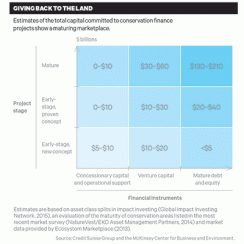In early 2013, Gunnela Hahn, head of responsible investment for the €725 million ($811 million) portfolio overseen by the Church of Sweden, convinced her board of directors to take a leap of faith. The board voted to allocate €10 million to the inaugural fund offered by London-based Althelia Ecosphere, which aims to profit from investing in sustainable land use in Africa, South America and elsewhere.
Part of a burgeoning field called conservation finance, Althelia’s fund appealed to the Swedish church for several reasons. “I think the upside was very attractive, both financially and from a sustainability point of view,” Hahn says. The diversification benefits were another selling point, she adds: “We preferred it to private equity; it’s a real asset that you can see.”
At €100 million Althelia, the managers of the Climate Fund 1 look for opportunities that can generate multiple revenue streams. Among the fund’s investments: $7 million in financing for a $9.15 million farmer-owned cooperative that oversees the long-term protection of 570,000 hectares of rain forest in the Madre de Dios region of southeastern Peru . Some of the money will go toward deploying sustainable agricultural practices at more than 1,100 small cocoa farms. When the project reaches full scale, it will produce at least 3,200 metric tons of certified deforestation-free organic and Fairtrade cocoa annually, Althelia claims. Over the next seven years, the investment will also prevent the emission of 4 million metric tons of carbon from deforestation, the firm says, providing more revenue in the form of carbon credits.
So far, the Althelia fund has paid off for the Church of Sweden, according to Hahn, who says the return has been in the double digits.
Other investors in Althelia include AXA Investment Managers and Credit Suisse Group. Paris-based AXA IM contributes via its €200 million AXA Impact Fund, whose investors comprise 14 insurance companies; Credit Suisse has taken a stake on behalf of its institutional and high-net-worth clients.
In January the Swiss bank and the McKinsey Center for Business and Environment published a report called Conservation Finance — From Niche to Mainstream: The Building of an Institutional Asset Class . This follow-up to a 2014 study by Credit Suisse, consulting firm McKinsey & Co. and the World Wildlife Fund focuses on the swift rise of conservation finance toward mainstream acceptance and examines what must happen to sustain that trend.

Each year about $52 billion flows into conservation projects, the report notes, with the bulk of that total coming from public and philanthropic funders. The authors estimate that the world will need between $300 billion and $400 billion annually to preserve healthy ecosystems on land and in the oceans — and that private capital will have to pick up nearly all of the slack.
There are encouraging signs. In 2014, New York–headquartered EKO Asset Management Partners (now Encourage Capital) and NatureVest , the impact investing branch of the Arlington, Virginia–based Nature Conservancy, surveyed 56 investors — including fund managers, foundations and family offices — on their appetite for conservation finance. Between 2009 and 2013 the private investors in this group more than doubled their allocations compared with the previous five years, from a combined $892 million to $1.9 billion.
Sylvain Goupille, a co-founder and managing partner of Althelia, thinks policy discussions are a big driver of interest in conservation finance. Citing talks about sustainable land use and market mechanisms at December’s Conference of the Parties to the United Nations Framework Convention on Climate Change in Paris, Goupille also credits the progress of pioneering nonprofits and foundations in developing conservation investment products .
“The market is moving from small, unique transactions toward more standardized, replicable and scalable transactions,” he says. “It might be too early to call it an asset class, but there is clearly a lot of interest from investors.”
Just ask Fabian Huwyler, a Zurich-based vice president in the sustainability affairs group at Credit Suisse who leads the bank’s conservation finance efforts and was lead author of its recent report. Huwyler points out that Credit Suisse’s annual conservation finance conference has grown from 30 participants at the inaugural event in 2014 to a sold-out crowd of 200 in New York this past January.
“Three years ago it was a niche topic,” he says. “Now we have mainstream investors and pension funds that see conservation as a topic that could be of interest.”
There’s far more willing capital than products to absorb it, observes Huwyler, who wants to see venture capitalists help conservation start-ups grow. He believes venture investors are ideal for conservation finance because they’re used to taking on high risk for potentially high returns.
“If you want to grow into an institutional asset class, you have to accept that you compare with traditional asset classes,” stresses Huwyler, noting that the feel-good aspect of conservation finance doesn’t matter to the mainstream investor: “He or she wants to see the same returns.”






